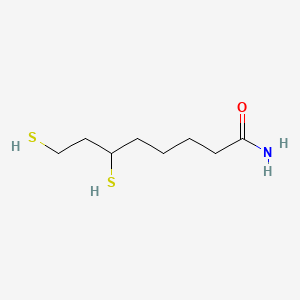| MeSH term | MeSH ID | Detail |
|---|---|---|
| Parkinsonian Disorders | D020734 | 20 associated lipids |
Dihydrolipoamide
Dihydrolipoamide is a lipid of Fatty Acyls (FA) class. Dihydrolipoamide is associated with abnormalities such as Wiskott-Aldrich Syndrome. The involved functions are known as Citric Acid Cycle, Electron Transport, NADH oxidation, Oxidation and Oxidants. Dihydrolipoamide often locates in Mitochondria, Mitochondrial matrix and Chloroplasts. The associated genes with Dihydrolipoamide are Mutant Proteins, Recombinant Proteins, mycothione reductase, Genes, Mitochondrial and alanylproline.
Cross Reference
Introduction
To understand associated biological information of Dihydrolipoamide, we collected biological information of abnormalities, associated pathways, cellular/molecular locations, biological functions, related genes/proteins, lipids and common seen animal/experimental models with organized paragraphs from literatures.
What diseases are associated with Dihydrolipoamide?
Dihydrolipoamide is suspected in and other diseases in descending order of the highest number of associated sentences.
Related references are mostly published in these journals:
| Disease | Cross reference | Weighted score | Related literature |
|---|
Possible diseases from mapped MeSH terms on references
We collected disease MeSH terms mapped to the references associated with Dihydrolipoamide
PubChem Associated disorders and diseases
What pathways are associated with Dihydrolipoamide
There are no associated biomedical information in the current reference collection.
PubChem Biomolecular Interactions and Pathways
Link to PubChem Biomolecular Interactions and PathwaysWhat cellular locations are associated with Dihydrolipoamide?
Visualization in cellular structure
Associated locations are in red color. Not associated locations are in black.
Related references are published most in these journals:
| Location | Cross reference | Weighted score | Related literatures |
|---|
What functions are associated with Dihydrolipoamide?
Related references are published most in these journals:
| Function | Cross reference | Weighted score | Related literatures |
|---|
What lipids are associated with Dihydrolipoamide?
There are no associated biomedical information in the current reference collection.
What genes are associated with Dihydrolipoamide?
Related references are published most in these journals:
| Gene | Cross reference | Weighted score | Related literatures |
|---|
What common seen animal models are associated with Dihydrolipoamide?
There are no associated biomedical information in the current reference collection.
NCBI Entrez Crosslinks
All references with Dihydrolipoamide
Download all related citations| Authors | Title | Published | Journal | PubMed Link |
|---|---|---|---|---|
| Bryk R et al. | Metabolic enzymes of mycobacteria linked to antioxidant defense by a thioredoxin-like protein. | 2002 | Science | pmid:11799204 |
| Fujiki Y et al. | Activation of the promoters of Arabidopsis genes for the branched-chain alpha-keto acid dehydrogenase complex in transgenic tobacco BY-2 cells under sugar starvation. | 2002 | Plant Cell Physiol. | pmid:11917081 |
| Chen HJ et al. | Lipoyl dehydrogenase catalyzes reduction of nitrated DNA and protein adducts using dihydrolipoic acid or ubiquinol as the cofactor. | 2002 | Chem. Biol. Interact. | pmid:12204577 |
| Porras P et al. | Glutaredoxins catalyze the reduction of glutathione by dihydrolipoamide with high efficiency. | 2002 | Biochem. Biophys. Res. Commun. | pmid:12135599 |
| Ottosson F et al. | Genetic variation in three species of Hordeum, and the selection of accessions for the Barley Core Collection. | 2002 | Hereditas | pmid:12564627 |
| Koti RS et al. | Effect of ischemic preconditioning on hepatic microcirculation and function in a rat model of ischemia reperfusion injury. | 2002 | Liver Transpl. | pmid:12474159 |
| Wu YY et al. | Proteinase 3 and dihydrolipoamide dehydrogenase (E3) are major autoantigens in hepatitis C virus (HCV) infection. | 2002 | Clin. Exp. Immunol. | pmid:11985526 |
| Cicek G et al. | Analysis of mitochondrial antigens reveals inner membrane succinate dehydrogenase flavoprotein subunit as autoantigen to antibodies in anti-M7 sera. | 2002 | Clin. Exp. Immunol. | pmid:11982594 |
| Pedrajas JR et al. | Two isoforms of Saccharomyces cerevisiae glutaredoxin 2 are expressed in vivo and localize to different subcellular compartments. | 2002 | Biochem. J. | pmid:11958675 |
| Olsson C | Distribution and effects of PACAP, VIP, nitric oxide and GABA in the gut of the African clawed frog Xenopus laevis. | 2002 | J. Exp. Biol. | pmid:11919271 |
| Phelps PE et al. | Evidence for a cell-specific action of Reelin in the spinal cord. | 2002 | Dev. Biol. | pmid:11900467 |
| Moran JF et al. | Molecular cloning, functional characterization, and subcellular localization of soybean nodule dihydrolipoamide reductase. | 2002 | Plant Physiol. | pmid:11788775 |
| Argyrou A et al. | The lipoamide dehydrogenase from Mycobacterium tuberculosis permits the direct observation of flavin intermediates in catalysis. | 2002 | Biochemistry | pmid:12463758 |
| Broughton BR and Donald JA | Nitric oxide regulation of the central aortae of the toad Bufo marinus occurs independently of the endothelium. | 2002 | J. Exp. Biol. | pmid:12200412 |
| Jacobia SJ et al. | Characterization of a missense mutation at histidine-44 in a pyruvate dehydrogenase-deficient patient. | 2002 | Biochim. Biophys. Acta | pmid:11781147 |
| Gazaryan IG et al. | Zinc is a potent inhibitor of thiol oxidoreductase activity and stimulates reactive oxygen species production by lipoamide dehydrogenase. | 2002 | J. Biol. Chem. | pmid:11744691 |
| Jordan P et al. | Diversity in coding tandem repeats in related Neisseria spp. | 2003 | BMC Microbiol. | pmid:14611665 |
| Bittel C et al. | The oxidant-responsive diaphorase of Rhodobacter capsulatus is a ferredoxin (flavodoxin)-NADP(H) reductase. | 2003 | FEBS Lett. | pmid:14572660 |
| Nordman T et al. | Regeneration of the antioxidant ubiquinol by lipoamide dehydrogenase, thioredoxin reductase and glutathione reductase. | 2003 | Biofactors | pmid:14695919 |
| Moreau R et al. | Age-related increase in 4-hydroxynonenal adduction to rat heart alpha-ketoglutarate dehydrogenase does not cause loss of its catalytic activity. | 2003 | Antioxid. Redox Signal. | pmid:14580306 |
